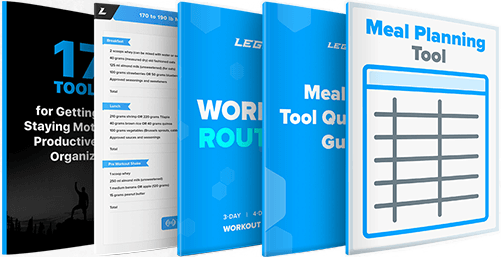
Double progression is a simple, time-proven workout programming strategy that anyone can use to get fitter and stronger.
It works with any exercise, workout routine, and fitness goal.
The term “double progression” was first coined by author, businessman, and bodybuilding pioneer Alan Calvert in a pamphlet he published in 1911. Now, over 100 years later, it’s still one of the most effective ways to keep gaining muscle and strength whether you’re a newbie in the iron game or a hard-nosed veteran.
Read on to learn what double progression is, how it works, and how to use it in your training.
Would you rather watch a video? Click the play button below!
Want to watch more stuff like this? Check out my YouTube channel!
What Is Double Progression?
Double progression is a method of regulating how to increase the volume and intensity of your training.
It works like this: you work in a certain rep range (4-to-6, for example), and once you hit the top of that rep range for a certain number of sets (one, two, or three, usually), you increase the weight (normally by 5 or 10 pounds).
Then, if you can at least hit the bottom of your rep range with the new, heavier weight, you work with it until you reach the progression rep and set targets again, increase the weight again, and so forth.
In other words, you strive to first increase reps (volume) and then “cash in” that progress to increase weight (intensity). Hence, “double progression.”
Double Progression vs. Single Progression
Single progression is what many people do when they first start lifting weights—they try to regularly add weight to an exercise while doing the same number of reps and sets in each workout. Only the weight goes up, hence, “single progression.”
Here’s how this could look for someone doing three sets of squats in a workout once per week:
Week 1: 185 x 5, 185 x 5, 185 x 5
Week 2: 195 x 5, 195 x 5, 195 x 5
Week 3: 205 x 5, 205 x 5, 205 x 5
This linear approach works well for people who are new to weightlifting, and it can be found in several successful strength training programs like Starting Strength, 5×5, and others.
The problem with single progression, though, is it starts to miscarry after your first 6-to-12 months of weightlifting (once your newbie gains dry up). Eventually, you can’t consistently add even small amounts of weight to the bar anymore without missing rep targets (getting 2 or 3 reps per set instead of 5, for instance).
Some people try to ignore this fact and force progression by redoubling their efforts. More pre-workout, louder music, and grittier grunting. This doesn’t work for long. Within a couple of weeks, they’re missing sets again, their technique is tottering, and their body is hurting. If they ignore these signs and press on, they land up ragged or injured.
Often, these people recover and repeat the cycle, perhaps peaking at a slightly higher weight than last time before backsliding again. And after rolling their proverbial rock up the hill several times like this, many conclude that they just don’t have the genetics/recovery ability/willpower to keep getting bigger and stronger.
This is almost never the case. The reason they’re stuck in the doldrums is poor programming, not a DNA or dedication deficiency. And one of the easiest ways to put wind back in their sails is to graduate from single progression to double progression.
This shift is easy to make, too. At bottom, all you’re doing is giving yourself a range of reps to work with instead of a set number, which makes your training more effective by implementing two elements of progressive overload instead of one—reps (volume) and weight (intensity), as opposed to just weight.
Let’s review a few examples to see how this works in practice.
Double Progression Method Examples
Let’s say you’re bench pressing in the 4-to-6-rep range for 3 sets, and on your first set, you get 6 reps with 135 pounds.
Your program calls for just one “top-rep set” to progress, so it’s time to increase the weight. You add 10 pounds to the bar (145 pounds), rest a few minutes, and get 4 reps on your next two sets of the exercise in that workout.
Because you’re still within your target rep range (4-to-6 reps) with 145 pounds, you’d keep working with it until you get 6 reps for one set, and then you’d increase the weight to 155 pounds.
Here’s how this could look over the course of 4 weeks.
| Set 1 | Set 2 | Set 3 | |
| Week 1 | 135 x 4 | 135 x 4 | 135 x 5 |
| Week 2 | 135 x 6 (target) | 145 x 4 (increase) | 145 x 4 |
| Week 3 | 145 x 4 | 145 x 5 | 145 x 5 |
| Week 4 | 145 x 6 (target) | 155 x 4 (increase) | 155 x 4 |
Note the difference between this approach and single progression. In a common approach to the latter (adding 10 pounds to the bar every week), you’d attempt to go from 135 pounds to 165 pounds in the same timeframe, but as we can see in the numbers above, your body wouldn’t be capable of that.
And what if you hit the top of your target rep range on the last set of an exercise?
In this case, you’d simply increase the weight on the first set of that exercise the next time you did that workout (the following week, generally). For example, if you bench pressed 155 x 6 on Friday, then you’d increase the weight to 165 the following Friday, when you do that workout again.
And what if you’re doing the same exercise several times per week?
I recommend that you progress on each exercise in each workout independently. That is, if you bench press on Mondays and Fridays, and you get 155 x 6 on Friday, you shouldn’t increase the weight in your Monday pressing—just your Friday session.
The reason for this is you experience varying levels of fatigue in each workout depending on your workout programming, lifestyle, and physiology.
For instance, if you train Monday through Friday and take the weekend off, as I do, you feel fresher on Monday (after two days of rest) than on Friday (after four days of training). Thus, you may find that you can progress faster in workouts earlier rather than later in the week.
On the other hand, if you perform an exercise later in a workout earlier in the week and then earlier in a session later in the week, you may find that your performance is better in the second workout because the “first-workout advantage” isn’t enough to offset the “later-in-the-workout” drawback.
So, since it’s hard to account for these variables in your programming, it’s best to progress on each exercise in each workout individually.
Another wrinkle worth noting:
During your first year or so of proper weightlifting with double progression, you’ll probably be able to add 10 pounds total to both barbell and dumbbell exercises as soon as you hit your progression rep target for one set, as shown in the example above.
At some point, though, this approach will cause you to miss the bottom of your rep range when you move up in weight.
Here’s how this might look:
| Set 1 | Set 2 | Set 3 | |
| Week 1 | 225 x 4 | 225 x 4 | 225 x 5 |
| Week 2 | 225 x 6 (target) | 235 x 5 (increase) | 235 x 4 |
| Week 3 | 235 x 5 | 235 x 5 | 235 x 4 |
| Week 4 | 235 x 6 (target) | 245 x 3 (miss) | 245 x 3 (miss) |
Notice that in week four, our weightlifter wasn’t able to get at least 4 reps with 245 pounds. When you reach this point (when one top-rep set isn’t enough to make your progress “stick”), and you will, you have several options for righting the ship:
- Decrease the weight by 5 pounds so you’ve only added 5 pounds instead of 10. This alone can be enough to fix the problem.
- If this doesn’t work—you still can’t stay in your rep range—reduce the weight to the original, lighter load and work there until you can do 2 top-rep sets in a single workout. (You’ll also have to use this method if the dumbbells in your gym go up in 5-pound increments and the smallest plates are 5 pounds.)
- If you do that, add weight, and find that you still can’t stay in your rep range, go back to the lighter weight and work with it until you can do 3 top-rep sets in a single workout. At this point, your progress should stick.
- If you’re doing more than 3 sets for an exercise in a workout and are struggling to stay in your rep range in all of them after adding weight, don’t increase the weight until you’ve reached your progression rep target in all of your sets. For instance, if you’re doing 5 sets of squats for 4-to-6 reps, you’d increase the weight only after doing 5 sets of 6 reps with a certain weight.
This is the type of double progression system that I use in my Bigger Leaner Stronger program for men and my Thinner Leaner Stronger program for women, and as thousands of people who have used those programs to build their best bodies ever can attest, it delivers the goods.
How to Make Double Progression Work for You
You can use double progression with any exercise by answering three questions:
1. What rep range will you use?
A good rule of thumb is that compound exercises, which involve multiple joints and muscle groups, are better suited to lower rep ranges (8 reps per set or fewer), and isolation exercises (single-joint movements that focus on one muscle group) are better suited to higher rep ranges (8 reps per set or more).
2. How close to failure will you go?
I recommend you take sets of your compound exercises to the point where you’re 2-to-3 reps shy of failure (when you can’t complete another rep with proper form), and that you take your isolation exercises to the point where you’re 1-to-2 reps shy of failure. In other words, end sets of compound exercises when you have 2-to-3 good reps left, and end sets of isolation exercises when you have 1-to-2 good reps left.
This may sound too cautious to you, but it’s an effective way to continue gaining muscle and strength while avoiding problems related to training too close to failure too often, including joint pain, injuries, fatigue, and soreness.
Despite what many people think, you have to train hard to keep progressing, but you don’t have to bust a gut on every set of every workout.
This advice applies to top-rep sets, too. It’s not enough to merely reach your progression rep and set targets—you have to do it with sufficient reps in reserve. There shouldn’t be any grinding.
So, let’s say you bench press 135 pounds for 6 reps (your progression rep target), and you feel like you could’ve gotten two more reps with good form. Bravo! Time to progress! If, however, you felt you could’ve gotten just one more good rep (and maybe one more sloppy one), keep working with 135 pounds until it feels a little lighter.
3. How many top-rep sets will you do before increasing the weight?
As explained a moment ago, if you’ve been lifting weights for less than a year, then you should have no trouble adding weight after one top-rep set.
If you’re a more experienced weightlifter, however, you’ll probably need to do two or even three top-rep sets before you can add weight without missing reps on subsequent sets.
Who Should Use Double Progression?
Anyone can use double progression to get bigger and stronger, but, as with any programming strategy, it’s better suited to some people than others.
Typically, double progression works well on all exercises for people who have two years or less of training experience.
There are exceptions, of course—some people are still profiting from double progression on both compound and isolation exercises after several years of training—but most people with 2+ years of weightlifting experience will find that double progression continues to perform well on isolation exercises but no longer moves the needle like it used to on compound exercises.
This is normal. I talk about why it happens in my book for intermediate and advanced weightlifters Beyond Bigger Leaner Stronger, but the fix is simple: switch to an effective periodized progression model for your compound exercises and continue using double progression with your isolation exercises.
+ Scientific References
- Pareja-Blanco, F., Rodríguez-Rosell, D., Aagaard, P., Sánchez-Medina, L., Ribas-Serna, J., Mora-Custodio, R., Otero-Esquina, C., Yáñez-García, J. M., & González-Badillo, J. J. (2020). Time Course of Recovery From Resistance Exercise With Different Set Configurations. Journal of Strength and Conditioning Research, 34(10), 2867–2876. https://doi.org/10.1519/JSC.0000000000002756
- Lacerda, L. T., Marra-Lopes, R. O., Diniz, R. C. R., Lima, F. V., Rodrigues, S. A., Martins-Costa, H. C., Bemben, M. G., & Chagas, M. H. (2020). Is Performing Repetitions to Failure Less Important Than Volume for Muscle Hypertrophy and Strength? Journal of Strength and Conditioning Research, 34(5), 1237–1248. https://doi.org/10.1519/JSC.0000000000003438
If you enjoyed this article, get weekly updates. It’s free.
Sending…
Great! You’re subscribed.
100% Privacy. We don’t rent or share our email lists.






